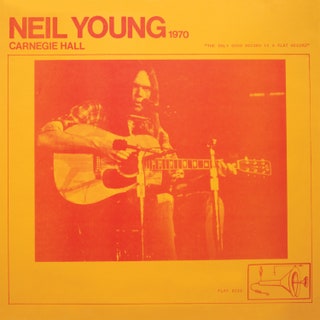A captivating solo performance at Manhattan’s most haunted showroom, the latest release in Neil Young’s ongoing archival project showcases a fascinating pivot point in his career.
By December 1970, Neil Young was America’s bizarro sweetheart. Over the course of three LPs with Buffalo Springfield and three acclaimed solo albums, he had mastered folk and rock idioms and alchemized them into something utterly sui generis. He could be churlish or tender like Dylan, he could rock like the Stones, he could harmonize like the Beatles and wax philosophical like the Dead. He was intensely cool with a side of creepy. Carnegie Hall 1970, the most recent entry into Young’s ambitious, ongoing archival project, reveals the emergent superstar accompanied only by acoustic guitar and piano, playing a stately survey of his early material before a rapturous audience of devotees. Like so much of his work, the concert feels oddly fraught with the portent of history: an icon-in-progress’ pilgrimage to Manhattan’s most haunted showroom, another journey through the past.
The year prior to Carnegie Hall, Young became a late addition to the commercial juggernaut Crosby, Stills & Nash, who were riding high on the universal acclaim and massive sales of their 1969 self-titled debut. Stephen Stills felt the need for a second guitar player and recommended his frenemy and former Buffalo Springfield bandmate; Graham Nash objected but Young was allowed to join, and he promptly made the group stranger, sadder, and more interesting on 1970’s follow-up Deja Vu. That album went on to sell a staggering eight million copies and made each of the performers household names, and yet Young improbably maintained an air of mystery. By the time he took the stage at Carnegie Hall, the 25-year-old artist had semi-miraculously threaded the needle between full-scale ambition and cult-figure credibility.
Consolidating these gains, the set contains a judicious and even generous survey of Young highlights from his Buffalo Springfield, solo, and CSN&Y days. Acoustic reworkings of guitar-freakout favorites like “Cowgirl in the Sand” and “Cinnamon Girl” verge on cordial while still retaining the patina of outlaw charm. The solo piano version of the Buffalo Springfield nugget “Nowadays Clancy Can’t Even Sing” strips the original of its psychedelic armor and arrives at the painful core of its existential striving. And a rueful version of “Ohio,” a recently issued response to the Kent State University shooting of four student Vietnam protesters, vibrates with rage. The concert transpired only seven months after the shooting occurred.
The overall mood is strangely collectivist for a performer so frequently inclined to build tension between himself and his audience. In an odd bit of abortive showmanship, he asks the crowd to sing along with a lilting take on “Sugar Mountain,” before stopping mid-song to encourage them to do better, and eventually giving up the gambit entirely. “See what happens when we try to please you?” he jokes with palpable exasperation.
Even within the show’s relatively sedate setting, there are hints of the artist whose future hallmarks would include aggressively raising the bar for in-concert sonic abuse and antagonism. A stunning version of “See the Sky About to Rain” previews a song that wouldn’t officially surface until 1974’s Ditch Trilogy linchpin On the Beach, and the brilliantly doleful bummer ride of “Bad Fog of Loneliness” hints at the shifting tradewinds of the hippie dream. Cast into bold relief alongside a surfeit of crowd-pleasing hits, these stark compositions suggest all the nervous, groundbreaking places Young was headed. In the years ahead, he would relish both his command of an audience and his license to confuse. He would leverage CSN&Y into a shockingly successful two-front war on the charts. He would pivot impulsively between ragtag country, manicured folk, and abrasive drunk-tank boogie. He would emerge from a deep and competitive field as the weirdest rock star ever. Warm, engaging, and magnetically solicitous, the Carnegie Hall show is a fascinating pivot point, showcasing Young at his most engaging and vulnerable, nailing one door shut and prying open another: It’s a last look back at the old folkie days and a tentative first reckoning with the wooly neurosis of a new decade.



0 comments:
Post a Comment